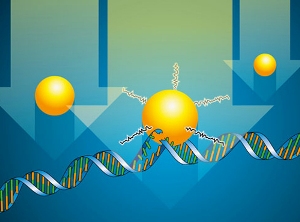May 13 2014
A new project at the National Physical Laboratory (NPL) will develop methodologies to measure the radio-biological impact of gold nanoparticles, when used in combination with ionising radiation for enhancing radiotherapy treatments and medical imaging.
 Gold nanoparticles absorb high levels of ionising radiation, boosting the impact of radiotherapy treatments that work by damaging DNA in tumour cells.
Gold nanoparticles absorb high levels of ionising radiation, boosting the impact of radiotherapy treatments that work by damaging DNA in tumour cells.
Nanoparticles are currently employed in several medical applications and many more have been suggested, with great potential benefits for patients and medical providers. Due to their high atomic mass, gold nanoparticles can absorb significantly more radiation than soft tissue cells, making them ideal for boosting the radiation dose in tumours or enhancing contrast of specific tissues during diagnostic imaging (e.g. doping a tissue with 1% of its weight with nanoparticles would double the radiation dose absorbed following kV X-ray exposure).
Taking advantage of gold's biocompatibility, nanoparticles can be injected intravenously and will naturally accumulate in any area of leaking vascularity such as tumours. Moreover, specific antibodies can be linked to the gold nanoparticles for more specific selectivity with particular types of cells. However, the amount and quality of the radiation effects enhanced by the nanoparticles strongly depend on several parameters such as cellular uptake of nanoparticles (smaller nanoparticles could penetrate the cell nucleus and interact with DNA molecules), nanoparticle size, concentration, charge and similar.
To safely and effectively use gold nanoparticles, therefore, we need to investigate and quantify the enhanced impact of radiation that they cause. This requires traceable measurements and rigorous standards to define and quantify key parameters, which will help optimise the treatments themselves and enable their regulation.
The new project will work towards this goal by employing expertise found across several different research groups at NPL, in collaboration with universities and research institutes from around the world.
The Radiation Dosimetry Group will calculate the enhanced radiation doses and study changes at the nano- and microscopic level following interaction of radiation beams with the nanoparticles. Radiation chemistry and radiobiology investigations will validate and complement the dosimetry studies in order to develop suitable models linking nanoparticle characteristics, energy deposition and biological response.
The Biotechnology Group will contribute with advanced microscopy techniques that can check the location and uptake of nanoparticles within cells and tissues. The Surface & Nanoanalysis Group will use nanotechnology techniques to characterise their physical properties and find the best methods of producing them.
There will be formal and informal collaboration with external researchers from organisations, including Queen's University Belfast and the University of Surrey, as well as input from the Nanotechnology Characterization Laboratory (NCL), part of the US National Institutes of Health. The characterisation methodology will be made available for the Medicine and Healthcare Products Regulatory Agency (MHRA), which is looking into regulating medical use of nanoparticles.
Giuseppe Schettino, from the Radiation Dosimetry Group at NPL, said:
"Unlike other related research, this multidisciplinary project will focus on developing a methodology to evaluate and quantify the effects of nanoparticles and radiation. We hope this will be very valuable for manufacturers and help with translating research from the laboratory into hospitals and clinics where it can benefit patients."